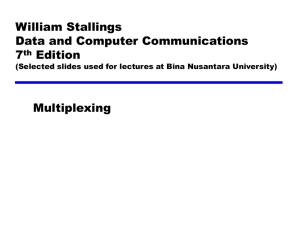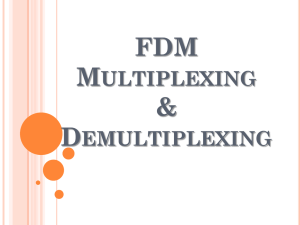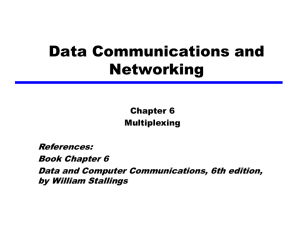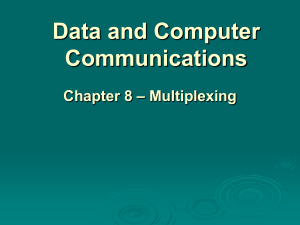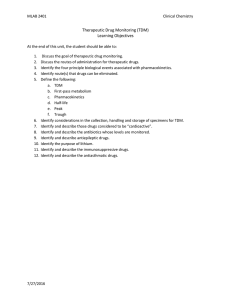Multiplexing References – Frequency
advertisement
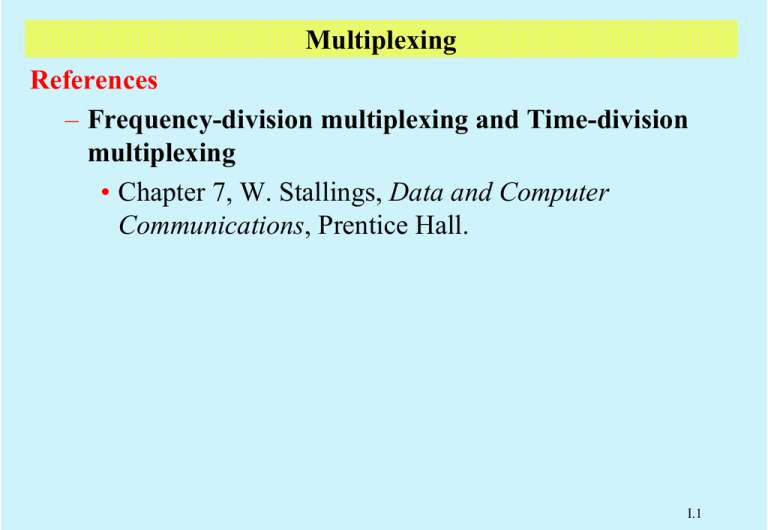
Multiplexing References – Frequency-division multiplexing and Time-division multiplexing • Chapter 7, W. Stallings, Data and Computer Communications, Prentice Hall. I.1 Introduction Introduction – Generally, two communicating stations will not utilize the full capacity of a data link • Example: transmit a voice signal over a optical fiber – Multiplexing allows multiple users sharing the capacity of a transmission link I.2 Introduction Components – Multiplexer • combines data from the n input lines – Link • with n separate channels • example: optical fiber or microwave link – Demultiplexer • separates the data according to channel • delivers them to the appropriate output lines I.3 Introduction Multiplexing Techniques Frequency-division multiplexing (FDM) – each channel occupies a fraction of the bandwidth of the link – a channel is defined by its center frequency, and its bandwidth. – Example: radio and television signal transmission I.4 Introduction Time-division multiplexing (TDM) – each channel occupies the entire bandwidth of the link for a very short period of time – a channel is made up of a sequence of time slots – Synchronous TDM • time slot are assigned to each channel in a regular sequence • Example: multiplexing digitalized voice signals and data streams I.5 Introduction – Statistical • improve the efficiency of synchronous TDM by adding complexity to the multiplexer • time slots are assigned to signals as they arrive at the multiplexer Code-division multiplexing (CDM) – each channel occupies the entire bandwidth – signals are differentiated by modulating them with orthogonal codes – mainly used for mobile communications I.6 FDM FDM – FDM is possible when the useful bandwidth of the medium excess the required bandwidth of signals to be transmission • (BWmedium >> BWsignal) • Example: voice signal is transmitted via an optical fiber – A number of signals are transmitted simultaneously if each signal is modulated onto a different carrier frequency, and the carrier frequencies are sufficiently separated that the bandwidths of the signals do not overlap I.7 FDM I.8 FDM Multiplexing – N sources are fed into a multiplexer – the multiplexer modulates each signal onto a different frequency – each modulated signal requires a certain bandwidth centered around its carrier frequency, referred to as a channel – The modulated signals are summed to produce a composite signal I.9 FDM – The composite signal transmitted across the medium is analog • The input signals may be either digital or analog • A digital signal must be passed through a modem I.10 FDM – to prevent interference, the channels are separated by guard bands, which are unused portions of the spectrum I.11 FDM Demultiplexing – At the receiving end, the composite signal is passed through N bandpass filters, each filter centered at f sci and having a bandwidth Bsci – Each component is then demodulated to recover the original signal I.12 FDM I.13 FDM Example: Transmitting 3 voice signals – the bandwidth of a voice signal is taken to be 4kHz, with an effective spectrum of 300 to 3400Hz I.14 FDM – If this signal is used to amplitude-modulate a 64 kHz carrier, the spectrum becomes – The modulated signal has a bandwidth of 8 kHz, extending from 60 to 68kHz. I.15 FDM – To make efficient use of bandwidth, we transmit only the lower sideband. – If three voice signals are used to modulate carriers at 64, 68, and 72 kHz, the spectrum is I.16 FDM Problems of FDM – Crosstalk • occur if the spectra of adjacent component signals overlap – Intermodulation noise • on a long link, the nonlinear effects of amplifiers on a signal in one channel could produce frequency components in other channels I.17 FDM Analog Carrier Systems – designed to transmit voiceband signals over high-capacity transmission links • Example: use coaxial cable and microwave systems I.18 FDM No. of voice channel Bandwidth Spectrum Group 12 48 kHz 60-108 kHz Supergroup 60 240 kHz 312-552 kHz Mastergroup 300 2.52 MHz 564-3084 kHz Jumbogroup 3600 16.984 MHz 0.564 - 17.584 MHz I.19 Synchronous TDM TDM – Synchronous TDM is possible when the achievable data rate (sometimes, unfortunately, called bandwidth) of the medium exceeds the data rate of digital signals to be transmitted. • rmedium >> rsignal – TDM is the time interleaving of samples from several sources so that the information from these source can be transmitted serially over a single communication link I.20 Synchronous TDM I.21 Synchronous TDM Transmitter – A number of signals are to be multiplexed onto the same transmission medium I.22 Synchronous TDM – The incoming data from each source are briefly buffered. • Each buffer is typically one bit or one character in length • The buffers are scanned sequentially to form a composite digital data stream • The scan operation is sufficiently rapid so that each buffer is emptied before more data can arrive – The composite digital signal stream may be transmitted directly or passed through a modem so that an analog signal is transmitted I.23 Synchronous TDM – The data are organized into frames. • Each frame contains a cycle of time slots. • In each frame, one or more slots is dedicated to each data source. • The sequence of slot dedicated to one source, from frame to frame, is called a channel I.24 Synchronous TDM – Length of slot • The slot length equals the transmitter buffer length, typically a bit or a character • The characteristic-interleaving technique is used with asynchronous sources. ¾Each time slot contains one character of data ¾The start and stop bits of each character are eliminated before transmission and reinserted by the receiver. I.25 Synchronous TDM • The bit-interleaving technique is used with synchronous sources and may also be used with asynchronous source ¾Each time slot contains just one bit I.26 Synchronous TDM Receiver – The interleaved data are demultiplexed and routed to the appropriate destination buffer. I.27 Synchronous TDM – Synchronous TDM is called synchronous not because synchronous transmission is used but because the time slots are preassigned to sources and fixed. – The time slots for each source are transmitted whether or not the source has data to send • capacity is wasted to simplify the hardware implementation – It is possible for a synchronous TDM device to handle sources of different data rates. For example, the slowest input device could be assigned one slot per cycle, while faster devices are assigned multiple slots per cycle. I.28 Synchronous TDM Pulse Stuffing – The most difficult problem in the design of a synchronous TDM system is the synchronization of various data sources. – If each source has a separate clock, any variation among clocks could cause loss of synchronization. – Also, in some cases, the data rates of the input data streams are not related by a simple rational number I.29 Synchronous TDM – With pulse stuffing, the outgoing data rate of the multiplexer, excluding framing bits, is higher than the sum of the maximum instantaneous incoming rates. • The extra capacity is used by stuffing extra dummy bits or pulses into each incoming signal until its rate is raised to that of a locally generally clock signal. • The stuffed pulses (bits) are inserted at fixed locations in the multiplexer frame format so that they may be identified and removed at the demultiplexer. I.30 I.31 Synchronous TDM Example: I.32 Synchronous TDM – – – – Source 1: Analog, 2 kHz bandwidth Source 2: Analog, 4 kHz bandwidth Source 3: Analog, 2 kHz bandwidth Source 4-11: Digital, 7200 bps synchronous – The analog sources are converted to digital using PCM • Sampling rate = 2 x bandwidth • The samples are quantized using a 4 bit A/D – For the digital sources, pulse stuffing is used to raise each source to a rate of 8 kbps I.33 Synchronous TDM – A frame can consist of multiple cycles of 32 bits, each containing 16 PCM bits and two bits from each of the eight digital source. I.34 Digital Carrier Systems Plesiochronous Digital Hierarchy (PHD) or TDM Hierarchy Multiplexing – At each step, the multiplexer has to take into account the fact that the clocks of the inputs are all slightly different. – Each clock is allowed a certain range of speeds. The multiplexer reads each input at the highest allowed clock speed. When there are no bits in the input buffer as the bits are arriving according to a slower clock, it adds a “stuffing” bit to “stuff” the signal up to the higher clock speed. I.35 Digital Carrier Systems Demultiplexing – It also has a mechanism to signal the demultiplexer that it has performed stuffing, and the demultiplexer must know which bit to throw it out. I.36 Digital Carrier Systems Digital Signal Number DS-1 Number of Voice Channels 24 Data rate (Mbps) DS-1C 48 3.152 DS-2 96 6.312 DS-3 672 44.736 DS-4 4032 274.176 DS-5 8064 560.160 1.544 (North American hierarchy) I.37 SONET/SDH Introduction – SONET (Synchronous Optical Network) is an optical transmission interface originally proposed by BellCore and standardized by ANSI (American National Standards Institute) – SONET is intended to provide a specification for taking advantage of the high speed digital transmission capability of optical fiber. – A compatible version, referred to as Synchronous Digital Hierarchy (SDH), has been published by ITU-T. I.38 Signal Hierarchy SONET Designation STS-1/OC-1 ITU-T Designation Data Rate (Mbps) 51.84 Payload rate (Mbps) 50.112 STS-3/OC-3 STM-1 155.52 150.336 STS-9/OC-9 STM-3 466.56 451.008 STS-12/OC-12 STM-4 622.08 601.344 STS-18/OC-18 STM-6 933.12 902.016 STS-24/OC-24 STM-8 1244.16 1202.688 STS-36/OC-36 STM-12 1866.24 1804.032 STS-48/OC-48 STM-16 2488.32 2405.376 I.39 Statistical TDM – In a synchronous time-division multiplexer, it is generally the case that many of the time slots in a frame are wasted. – The statistical multiplexer allocates time slots dynamically on demand. – The statistical multiplexer has n I/O lines but only k, where k < n, time slots available on he TDM frame. I.40 Statistical TDM – For input, the function of the multiplexer is to scan the input buffers, collecting data until a frame is filled, and then send the frame. – On output, the multiplexer receives a frame and distributes the slots of data to the appropriate output buffers. – Address information is required to assure proper delivery. As a result, there is more overhead per slot for statistical TDM as each slot carries an address as well as data I.41 Statistical TDM I.42 Code division multiplexing – CDM produces a wideband, noiselike signal, and it occupies the entire range of frequencies allocated to the system. – Discrimination between the signals is achieved through the assignment of unique spreading codes (all codes are orthogonal) I.43 Code division multiplexing I.44
